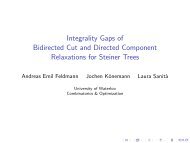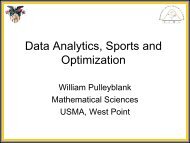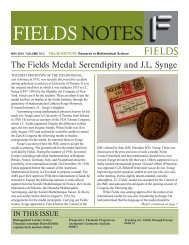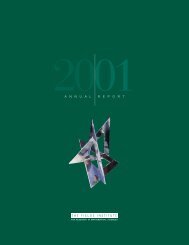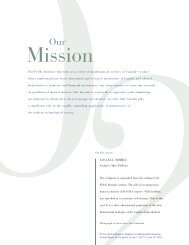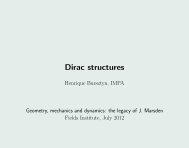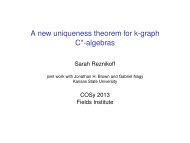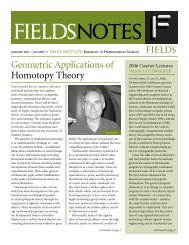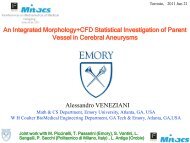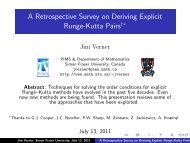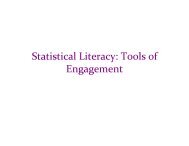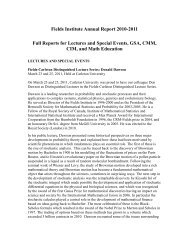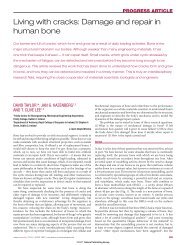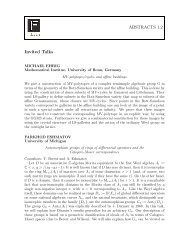Annual Report 2005 - Fields Institute - University of Toronto
Annual Report 2005 - Fields Institute - University of Toronto
Annual Report 2005 - Fields Institute - University of Toronto
You also want an ePaper? Increase the reach of your titles
YUMPU automatically turns print PDFs into web optimized ePapers that Google loves.
John MacGregor (McMaster)<br />
Latent variable methods for process analysis, monitoring and<br />
design<br />
Alex Rubinov (U. Ballarat)<br />
Unsupervised and supervised classification via nonsmooth<br />
optimization<br />
Yong Shi (Nebraska)<br />
Data mining techniques via multiple criteria optimization<br />
approaches<br />
Martin Wainwright (Berkeley)<br />
Mathematical programming and statistical models based on<br />
graphs<br />
Stephen Wright (Wisconsin-Madison)<br />
A review <strong>of</strong> some optimization techniques in machine learning<br />
and statistics<br />
Stanley Young (National Inst. Statistical Sciences)<br />
Identifying and solving important/complex problems<br />
The 11th International Conference on DNA Computing<br />
(DNA11)<br />
June 6–9, <strong>2005</strong><br />
Held at the <strong>University</strong> <strong>of</strong> Western Ontario<br />
Organizers: Lila Kari and Mark Daley (UWO)<br />
DNA Conference participants<br />
G e n e r a l S c i e n t i f i c A c t i v i t i e s<br />
Biomolecular computing has emerged as an interdisciplinary<br />
field that draws together computer science,<br />
mathematics, molecular biology, chemistry and physics.<br />
Our knowledge <strong>of</strong> DNA nanotechnology and biomolecular<br />
computing increases dramatically with every passing year.<br />
The international meeting on DNA Computing (formerly<br />
DNA Based Computers) has been the main international<br />
forum where scientists with different backgrounds, yet<br />
sharing a common interest in computing, meet and present<br />
their latest results. The 11th International Meeting on DNA<br />
Computing, now under the auspices <strong>of</strong> the International<br />
Society for Nanoscale Science, Computation and Engineering<br />
(ISNSCE), focuses on the current experimental and<br />
theoretical results with the greatest impact.<br />
DNA11 was organized by Lila Kari (DNA11 Organizing<br />
Committee Chair and newly elected Chair <strong>of</strong> the DNA<br />
Computing International Steering Committee) and Mark<br />
Daley (DNA11 Organizing Committee Vice-Chair). With<br />
a total <strong>of</strong> 150 participants, DNA11 was the best attended<br />
DNA Computing conference to date.<br />
The first day <strong>of</strong> the meeting was devoted to tutorials on<br />
computer science, molecular biology and DNA nanotechnology.<br />
Four 55-minutes invited talks were delivered by senior<br />
scientists. Eshel Ben-Jacob (Tel Aviv <strong>University</strong>) spoke on<br />
bacterial intelligence and DNA computing. James Gimzewski<br />
(<strong>University</strong> <strong>of</strong> California, Los Angeles) described<br />
recent works exploring nanomechanical characterizations<br />
<strong>of</strong> cell bacteria and proteins. Pehr Harbury (Stanford<br />
<strong>Fields</strong> <strong>Institute</strong> <strong>2005</strong> ANNUAL REPORT 84



